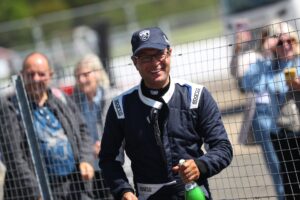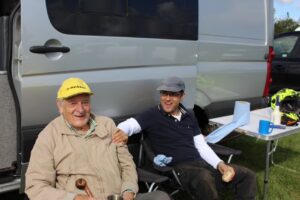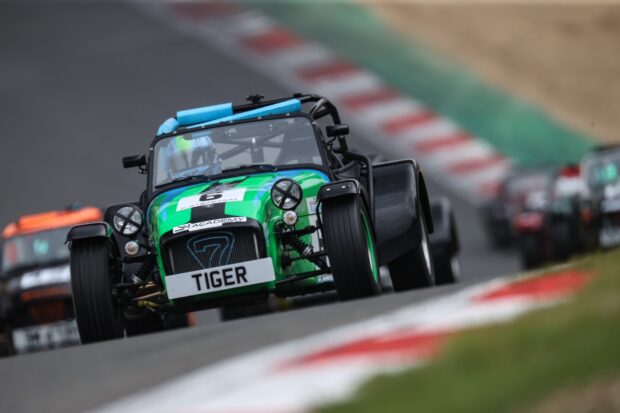After Tim Hardcastle zipped along the straights of the Silverstone Race Circuit in England earlier this year, the InsurTech CEO stood on the podium, shaking a bottle of prosecco, celebrating his third-place finish and bubbling up with memories.
It was Father’s Day. Years ago, his late father, Anthony, the man who had instilled in him a love of racing, brought him to the very grandstands he had just cruised past, planting the dream of one day becoming a race car driver in his son.
As he grew, Hardcastle’s life steered away from engines and exhaust pipes and toward running a successful insurance technology company and raising a family. Major life events and realizations recently reopened the door to his lifelong goal.

And last year, he placed 12th in one of Caterham Academy Championship’s two novice racing groups.
“As we all progress through our lives, we’re influenced by, to some extent, our parents, our backgrounds — things that shape us as we’re young people,” Hardcastle, who lives on England’s South Coast, said during a recent interview. “And for me, my dad was quite an influential figure in terms of his impact on me for generating my interest in cars and motor racing.”
Hardcastle, 60, was headhunted into insurance by Hiscox, where he held a technology leadership role for a year. That experience, coupled with prior background with major business applications in other industries, formed his view that insurance was not being well served by available technology.
So, in 2012, he cofounded INSTANDA, a customizable SaaS-based policy administration platform.

Years before his career began, though, Hardcastle’s father, Anthony, took him to racing events and car shows, leaving what Tim described as an “indelible mark” of interest on him. But the younger Hardcastle did not race for years. Furthering his company and spending time with his family took priority.
“When you set up a business like [INSTANDA], and you have all that passion and belief about it, it becomes all-consuming in a good way,” he said. “But it doesn’t give you any spare time for anything else, other than my family. And I managed to navigate the demands of INSTANDA with my family.”
Part of that family time was running his son’s national-level motocross race team. They’d load up their camper van on Friday nights, travel into the UK countryside, and Hardcastle would watch his son, Tom, chase his passion at a highly competitive level for about five years.
“So, I had this competitive exposure,” Hardcastle said, “and that kind of reignited, I think, my interest in motorsport from when I was a kid.”
His father passed away in 2023. Five months later, while skiing with his family on his first vacation in about a decade, Hardcastle realized his company had reached a point where it no longer needed his daily involvement.
The combination of these two factors propelled him to chase his own racing dreams. And so, a while after his son hung up his racing boots, Hardcastle sat in the driver’s seat for the first time. His first season of Caterham racing began in April and finished in August.
“That little holiday experience gave me a little indication the company’s matured a little bit,” Hardcastle explained. “My dad’s passing, I felt that was it. I need to get on and realize my own dream, which follows the INSTANDA dream. That’s my biggest dream in the last 10 years. But the other dream of trying to get racing came back, and that’s what triggered it all up.”
Tim raced in the Caterham Academy circuit, which bills itself as “a unique series exclusively for novice drivers.” Each racer that signs up receives a Caterham Seven road-legal race car, a race license, technical support, the racing itself and the guidance of the Caterham team.
The tubular, open-topped sports cars don’t look like modern race cars.
They were designed in the 1950s by Colin Chapman, the founder of Lotus Cars. The Caterham Seven that Hardcastle drove can accelerate to 60 mph in 5.3 seconds. Caterham’s website says the car weighs 1,378 pounds (including the driver’s weight); the car’s max speed can reach approximately 115 mph.
“It looks a bit quirky,” Hardcastle said with a laugh. “It looks a bit odd. But it’s a very effective machine for going around a racetrack. It goes very quickly through the corners. It’s low weight, so you can break later.”
The academy series offered all 50 drivers a chance to compete equally; they all raced with the same car, on the same tires and without performance-enhancing modifications. Hardcastle drove his car in all seven academy championship races. He finished in 12th place on the series leaderboard.
“It’s a very fair series,” Hardcastle said. “Everything is just on a level. And I like that. And then it’s just down to you as a driver to do your best and see how good you are.”
The pressure of racing is something he felt almost immediately.
Most people can drive a car quickly in a non-competitive situation, Hardcastle said. When it comes to racing, though, “the pressure suddenly becomes very different. You’re on a grid with 25 other cars — or in the case of Silverstone, there were 50 cars on the grid — and you’ve got the lights counting down … and then you’ve got to go.”
When reflecting on his memories of the circuit, Hardcastle said it’s interesting to see how people handle the intense pressure that comes with the race build-up and the necessary reactions and decisions that come with maneuvering through the tracks. It’s something that can’t be rehearsed.
“And honestly, I didn’t know how I was going to react,” he said.
Most of the time, he was “pretty relaxed and not getting too erratic and not overreacting,” he remembered. He believes that in sport, ultimately, mental strength is what separates the greats. He could see that even at the academy level. Some drivers responded better in stressful situations than others.
Hardcastle sees parallels between that and starting a business.
“When you set a business up, and it’s your big thing, and you’ve put all of your money into it and you’re risking things, how do you react when things don’t go as well as you expect?” he asked. “What do you do? And so, I think there are similarities, just from the psychology of it.”
Hardcastle will return to racing again this spring. He will jump up a couple of competition levels and plans to double down on preparation to achieve an even better outcome this time around. He’s eager to challenge himself.
He’s chasing a goal that, for so long, was only a dream.
“I’ve found [that] when you put your energy behind something and you believe in it, then good things will happen,” Hardcastle said.





















 Rebuilding Negotiation Talent: Why This Skill Is Missing and How to Fix It
Rebuilding Negotiation Talent: Why This Skill Is Missing and How to Fix It  ‘Dream Is in Sight:’ Chamber, Reinsurers, Insurers Urge Florida to Stay the Course
‘Dream Is in Sight:’ Chamber, Reinsurers, Insurers Urge Florida to Stay the Course  Police Recover Swallowed Fabergé Pendant 6 Days After it Was Stolen
Police Recover Swallowed Fabergé Pendant 6 Days After it Was Stolen  How One MGU Grew Fivefold When Capacity Fled Cat-Prone Property Markets
How One MGU Grew Fivefold When Capacity Fled Cat-Prone Property Markets 